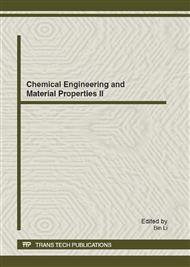[1]
J. P. Desvergne, A. W. Czarnik, Chemosensors of Ion and Molecule Recognition, Harcover, (1997).
Google Scholar
[2]
Fluorescent Chemosensors for Ion and Molecule Recognition, A.W. Czarnik, Ed.; American Chemical Society, Washington, DC, (1992).
Google Scholar
[3]
A. P. de Silva, H. Q. N. Gunaratne.
Google Scholar
[4]
P. Grandjean, P. Weihe, R. F. White and F. Debes, Environ. Res., 1998, 77, 165.
Google Scholar
[5]
T. Takeuchi, N. Morikawa, H. Matsumoto and Y. Shiraishi, Acta Neuropathol., 1962, 2, 40.
Google Scholar
[6]
M. Harada, Crit. Rev. Toxicol., 1995, 25, 1.
Google Scholar
[7]
P. Weilhe edited a special issue of EnVironmental Research devoted to mercury and derivatives as toxic elements. Grandjean, P. Environ. Res. Sect. A 1998, 77, 67-178.
Google Scholar
[8]
Yun, Z ; Yue S. Rhodamine-based chemosensor for Hg2+ in aqueous solution with a broad pH range and its application in live cell imaging [J]. Org. Biomol. Chem., 2010, 8, 4143–4147.
DOI: 10.1039/c0ob00013b
Google Scholar
[9]
Liu, B.; Tian, H. A selective fluorescent ratiometric chemodosimeter for mercury ion [J]. Chem. Commun. 2005, 315.
Google Scholar
[10]
Feng, L.; Chen, Z. Screening mercury (II) with selective fluorescent chemosensor [J]. Sensors and Actuators B. 2007, 122, 600.
DOI: 10.1016/j.snb.2006.07.007
Google Scholar
[11]
Ou, S.; Lin, Z.; Duan, C.; Zhang, H.; Bai, Z. A sugar-quinoline fluorescent chemosensor for selective detection of Hg2+ ion in natural water [J]. Chem. Commun. 2006, 4392 Demchenko, A. P. Introduction to Fluorescence Sensing; Springer: New York, (2009).
DOI: 10.1039/b607287a
Google Scholar
[12]
Cao, H.; Diaz, D. I.; DiCesare, N.; Lakowicz, J. R.; Heagy, M. D. Org. Lett. 2002, 4, 1503–1505. Valeur, B. Molecular Fluorescence Principles and Applications; Wiley-VCH: NewYork, (2002).
DOI: 10.1021/ol025723x
Google Scholar
[13]
Cao, H.; Xiong, Y.; Wang, T.; Squier, T. C.; Mayer, M. U. J. Am. Chem. Soc. 2007, 129, 8672–8673.
Google Scholar
[14]
Abass, M. Heterocycles 2005, 65, 901.
Google Scholar
[15]
Michael, J. P. Nat. Prod. Rep. 1997, 14, 605.
Google Scholar
[16]
Michael, J. P. Nat. Prod. Rep. 2002, 19, 742.
Google Scholar
[17]
Newkome, G. R.; Paudler, W. W. Contemporary Heterocyclic Chemistry; Wiley, New York, 1982; pp.199-231.
Google Scholar
[18]
Muchowski, J. M.; Maddox, M. L. Can. J. Chem. 2004, 82, 461.
Google Scholar
[19]
Maguire, M. P.; Sheets, K. R.; McVety, K.; Spada, A. P.; Zilberstein, A. J. Med. Chem. 1994, 37, 2129.
Google Scholar


